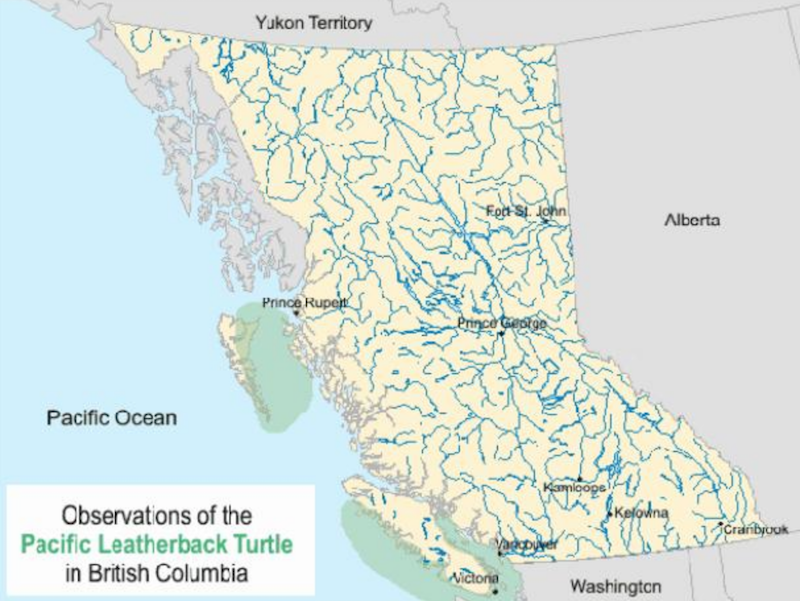I am willing to bet that Leatherback Sea Turtles are one of the last marine creatures that BC sport fishermen and boaters would expect to encounter on a fishing or cruising trip. I know that I fall into that category and in fact I didn’t even realize that the BC coast was part of their traditional range. It is, however, and while reported sightings are very rare at around 100 over the last 80 years, the BC Cetacean Sightings Network, working in conjunction with the Department of Fisheries and Oceans, are soliciting the help of anglers and boaters in reporting all sightings along our west coast. From a data collection perspective it makes sense to involve recreational anglers in this program because many more are now venturing into coastal areas where little if any sport fishing occurred in previous decades. Prior to 1990, the bulk of sport fishing activity took place inside the Strait of Georgia. There were also significant additional summer fisheries in Juan de Fuca Strait and the inshore waters of Barkley and Nootka Sounds, along with smaller pockets of activity near Port Hardy and throughout the north coast near populated areas and fishing resort complexes. Today the Georgia Strait fishing effort has fallen off dramatically while the angling traffic in northern BC has continued to increase. The big change has taken place along the west coast of Vancouver Island, where fishermen are exploring the offshore waters for salmon, halibut and now tuna. These changes in fishing patterns and the interest in fishing for new species have really expanded the geographic reach of BC’s salt water sport fisheries, which should put more eyes in areas where Leatherbacks might be found.
Advertisement

Leatherback turtles are listed as endangered under Canada’s Species at Risk Act (SARA) and they have a critically endangered listing on a worldwide basis. They are found in all of the major oceans in the world, except in the most extreme northern and southern latitudes, and consist of four major populations divided into Atlantic, Pacific, Indian and South China Sea groupings. One of the reasons they are so widely distributed is because they have the unique ability amongst reptiles to internally regulate their body heat. This means they can adapt to colder sea temperatures which they encounter once they move away from the tropical latitudes on either side of the equator. These turtles are true ocean wanderers, often following the currents for up to 15,000 km a year. One tagged specimen apparently traveled just over 30,000 km in a single year. Consequently their principal nesting areas are widely dispersed across the world’s major oceans. They prefer expansive sandy beaches and nesting sites are located in the Caribbean, along the northeast shoreline of South America, western Africa and in Southeast Asia. They are also extremely large, weighing from over 300 to nearly 600 kg at maturity, and are the fourth largest reptile in the world after three species of crocodiles. Since they spend their entire lives at sea, they have evolved to fit a lifetime of ocean travel. Their bodies are long and tear-drop shaped, their shells are covered with skin, their rear feet are webbed where they join with the tail and their front flippers are very large, averaging nearly two meters in length. Jellyfish are their principal source of food and it is thought that they help to control jellyfish numbers. They have been known to dive up to 1000 meters in search of food. The name “leatherback” comes from the appearance and color of the skin over their shell, which can include combinations of colors like black, grey and olive green that may be mottled with patches of yellow and cream.
Leatherbacks trace their lineage back to the days when dinosaurs walked on the earth. It is estimated that their line is 110 million years old. They can live from 30 to 100 years, but unfortunately the concerning state of the world’s population of leatherbacks is almost entirely due to human activity and interaction. Their eggs have provided coastal peoples with an easily accessed food source. Consequently egg over-harvesting combined with a continual erosion of good nesting habitat remains a significant problem. Because we share the ocean with them they are susceptible to being entangled in fishing nets and to collisions with almost any size of vessel. If you want to help with this project you can report sightings to sightings@vanaqua.org or you can access a survey questionnaire at www.surveymonkey.com/s/seaturtlebc.
Advertisement